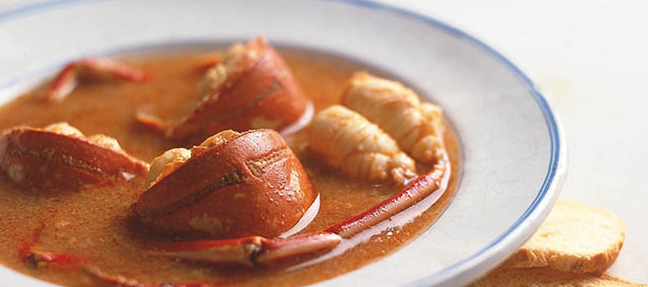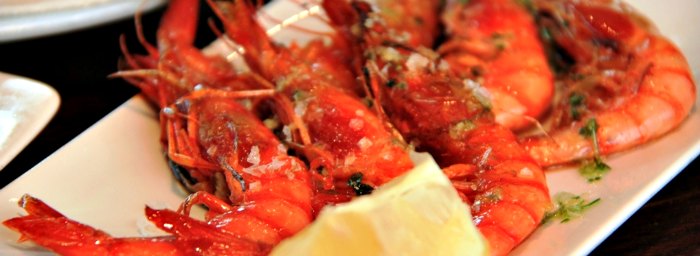Caldereta de Langosta
On the Balearic Islands, the locals argue over who has the best caldereta. Minorcans claim that their blue spiny lobsters are unequaled in the dish, while the Majorcans claim their light red lobsters are better. Despite that, it is perfectly possible to make an excellent caldereta de langosta using American lobster.
There are two primary species of lobster: the American lobster (Homarus americanus) and the European lobster (Homarus gammarus). In Spain, the former, known as bogavante, is caught in the Bay of Biscay and is highly valued. But when the Spanish refer to the langosta, they are talking about the European lobster, which is pulled from the Mediterranean Sea, is quite spiny in appearance, and is known in English as spiny lobster or rock lobster.
- Serves 4
Ingredients
- 2 (2-pound) live lobsters
- 1/3 cup plus 2 tablespoons olive oil
- 2 pounds tomatoes, cored and cut into eighths
- 1 (8-ounce) can tomato paste
- 2 yellow onions, chopped
- 1 small green bell pepper, seeded and chopped
- Salt
- Pinch of sugar
- 3 cloves garlic, peeled but left whole
- 1 tablespoon chopped fresh flat-leaf parsley
- 4 thin slices whole-grain country-style bread, toasted (optional)
- 4 teaspoons Alioli (optional)
Preparation
Place the live lobsters in ice water for 1 hour. The lobsters need to be alive to make this dish sublime, but they should not suffer when we kill them. Putting them in the ice water will help numb them.
In a skillet, heat the 1/3 olive oil over high heat. Add the tomatoes, tomato paste, onions, and bell pepper and cook, stirring often, for about 10 minutes, or until the vegetables begin to soften. Decrease the heat to medium, season with salt and the sugar, and cook for about 20 minutes, or until the mixture has thickened. Pass the mixtures through a food mill fitted with the medium plate held over a deep caldero or large saucepan. Pace on the stove top over the lowest heat setting possible. Keep an eye on the sauce, as you don't want it to scorch.
While the vegetables are cooking, remove the lobsters from the ice water and place them, belly down, on a cutting board. Working with 1 lobster at a time, and using a sharp knife, separate the head from the tail and remove the legs. Pull out and discard the insides, but reserve the liver (the greenish mass inside the head) and the roe if any (the reddish mass, also called the coral, found in females). Place the liver and roe in the refrigerator. Crack the legs open a bit with a small hammer, so that they will release more flavor when they ar broiled. If you are cooking American lobsters, reserve the claws, since they are very meaty, and cook them later with the tails.
In a small saucepan, combine the heads and legs with water to cover and bring to aboil over high heat. Decrease the heat to medium and simmer for about 30 minutes to create a flavorful stock. Strain the stock and set aside.
Cut each tail crosswise into 4 pieces and add them and the claws, if using American lobsters, to the simmering tomato sauce. With a wooden spoon or spatula, turn the lobster, mixing it well with the tomato sauce. Add the reserved stock, which should just cover the lobster. Season with salt, increase the heat to medium, and bring to a boil. Cover and cook for 20 minutes.
In a mortar, combine the garlic, parsley, the remaining 2 tablespoons olive oil, and the lobster liver and roe. Pound with a pestle until a uniform paste forms. Add the paste to the lobster and tomato sauce, mix well and cook for 5 minutes longer to blend flavors.
To serve, spread each bread slice with 1 teaspoon alioli and place in the bottom of a soup plate. Ladle the lobster pieces and plenty of liquid on top. Place an empty dish for the shells in the center of the table.
You may be also interested in...
See Also
Balearic Islands: The gastronomy from Majorca, Menorca, Eivissa·Ibiza and Formentera is comprised of many delectable and pleasurable dishes. The cuisine takes full advantage of the islands' resources and the many cultures which have passed through the archipelago over the years have left their mark: many different civilisations (Greeks, Phoenicians, Romans, Arabs, French, English...).
Spanish Seafood recipes: The long coastline of Spain, combined with the two archipelagos, the Balearics and the Canaries, ensures that fresh fish and shellfish are ubiquitous elements of the Spanish table.





